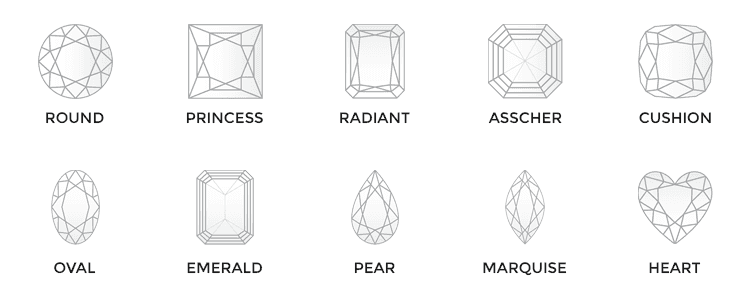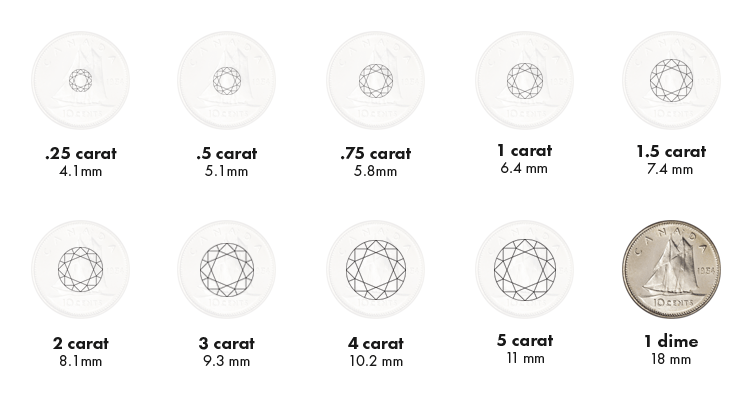Buying a diamond is a very personal experience.
Diamonds can be bought to signify love, significant accomplishments, and milestones in your life or that of a gift’s recipient. Unlike when you buy clothing, electronics, or cars, the features of a diamond may not seem quite so obvious to you.
We would like to change that...
The more you know about your diamond jewellery, the more confident you will feel when making your diamond jewelry choices. Take a moment to learn more about the 4Cs and find out how they play an important role in making your diamond jewelry unique.
Shape
The shape of the diamond is often confused with the cut. Choose the shape that you like based on your style and you cannot go wrong.

Cut
The cut of a diamond determines its brilliance or sparkle. Each shape will be cut differently. Before a diamond is cut, the location of inclusions and flaws, the natural coloration, and the original shape of the rough stone are studied extensively. The stone facets are then mapped out and cut in a way that maximizes size, shape, and clarity. For optimal light performance, you will want a diamond that is cut neither too shallow nor too deep.

Colour
Diamonds are graded based on the amount of colour they do or do not possess. The scale runs from D (colourless) to Z (light yellow). An absolutely colourless diamond is rare and therefore very valuable.

Clarity
A diamond is distinguished by its natural characteristics, just as a person would be noted for her blue eyes or his brown hair. Notated as a diamond’s clarity, these characteristics can be present on the surface (blemishes) or within the stone (inclusions).
The clarity is judged by the number and types of these characteristics and is designated using a scale that runs from Fl, defined as flawless, to I3, defined as inclusions visible with the naked eye. A flawless diamond is truly rare.
See all Natural Diamond selection Online

FL Diamonds
Flawless: No internal or external flaws.
IF Diamonds
Internally Flawless: No internal flaws.
VVS1, VVS2 Diamonds
Very, Very slightly included: Very difficult to see inclusions with 10x magnification.
VS1, VS2 Diamonds
Very Slightly Included: Inclusions are visible under 10x magnification to a skilled grader.
SI1, SI2 Diamonds
Slightly Included: Inclusions are visible under 10x magnification and may be visible with the unaided eye.
I1, I2, I3 Diamonds
Included: Inclusions are visible with the unaided eye.
Carat Weight
The unit of measure used for the weight of a diamond is the carat. As a matter of reference, a carat is equivalent to .2 grams or .007 of an ounce. Carat weight can also be divided further by using points. There are 100 points in one carat. So a 1/4 (.25) carat stone can also be expressed as 25 points and mean the same thing. When comparing two diamonds, please note that just because one is twice the carat weight of the other does not mean that it will appear to be twice the size.
Though the GIA only provides a concrete cut grade for round brilliant cut diamonds, there are some extra facets of diamond quality to keep in mind when opting for a non-round stone. One of these characteristics is the bow-tie effect. We’ll provide some clarity around common questions we receive regarding this non-measurable factor!

Seeing Is Believing!
When it comes to ideal cut diamonds, seeing truly is believing. Visit any of our locations for a demonstration of our diamond collections, or call to book a one-on-one consultation with one of our diamond experts to learn more about diamonds in general.
4 C’s of Lab-Grown Diamonds
Lab-grown diamonds are real diamonds with the same chemical composition as natural mined diamonds. Although they are man-made in a controlled environment, they still exhibit variations across the 4C’s – Carat, Color, Clarity, & Cut.
Lab-grown diamonds are a great budget-friendly option and are typically priced around 30%-50% less than natural diamonds. In this post, we’ll provide guidance on what to keep in mind when choosing a lab-grown based on the 4C’s.
While we typically suggest a certificate from the Gemological Institute of America (GIA) or other trusted labs for natural diamonds, for lab-grown stones we recommend a report from the International Gemological Institute (IGI). IGI offers a fully detailed report with specific colour and clarity grades.
Which Moissanite Should You Pick?
Moissanites have become very popular, and for good reason. They are an incredible option when working on a budget. They range from $800-$1,000 per carat when compared to diamond which starts at $7,000-$10,000 per carat until you get to 3 carats.
Why Moissanite?
Regardless of your reason, you can rely on moissanites. This man-made gemstone is a 9.5 on the Mohs hardness scale. This is just under diamond which is a 10, being the hardest. This means that moissanite is perfectly suitable for daily wear.
Quality
Made to resemble the highest quality diamond, there are no inclusions found in moissanites. Most are colourless DEF equivalent unless there is a different request. Every stone is measured in millimetre measurements which are translated into carat weights. These measurements will not vary, so every 2.10 ct. equivalent oval is 9x7mm and so on. Moissanites have more fire than real diamonds. This refers to the rainbow spectrum colour reflected back at the eye.
What Is The Bow-tie Effect In A Diamond?
The bow-tie effect in diamonds is a light or dark gray to black area running across the width of the stone. This dark area is created by a reflection of your head and shoulders blocking light from entering the diamond. Because of this, the closer you look at the diamond, the more pronounced the bow-tie will be.
What Diamond Shapes Feature A Bow-tie?
This effect is most common in elongated fancy cut diamonds like oval, marquise, radiant, and hearts. Each of these shapes will typically ALWAYS exhibit the bow-tie effect to some degree, but in well-cut stones, it should be minimal and not distracting.
Shouldn’t I Avoid Diamonds With A Bow-tie?
The assumption is yes, but stones with almost no bow-tie actually tend to look dull and often lack the faceting style people desire in a fancy cut diamond. On the other hand, you also don’t want a diamond with a bow-tie so large that it blacks out a large portion of the stone. The ideal scenario is to have a bow-tie that adds to the diamond’s fire and scintillation and helps create the characteristic facet patterns for its shape.
How Do I Select A Diamond That Contains A Bow-tie?
A diamond’s bow-tie is not pictured or stated on its grading report. It also is challenging to rely on metrics such as symmetry grade and proportions to judge a diamond’s light performance.
It’s also important to keep in mind that selecting a diamond comes down to personal preference. What one person finds attractive may not be to another. This is certainly the case when it comes to selecting a diamond with a bow-tie.
You can always email us to arrange an in-person or remote consultation with one of our diamond experts for additional guidance at email@bobthompsonjewellers.com. We have a large inventory of diamonds with a variety of quality and proportions to help you find your ideal stone based on your preferences!
How Does Cut Affect Clarity?
Different diamond shapes have different standards for clarity. A brilliant-cut stone, like a round brilliant, will more easily conceal any inclusions within the diamond due to its brilliant-cut facet arrangement. Other brilliant-cut shapes include pear, marquise, radiant and oval. For brilliant-cut shapes, you can opt for a lower clarity grade knowing that as long as it is eye-clean, the inclusions should not be visible.
An emerald cut, for example, is classified as a step-cut diamond. Because of the transparency of this stone, you can see right through it, as the facets are fewer and more open. We would recommend going VS2 or higher for a step cut’s clarity grade.
How Does Size Affect Clarity?
The size of the diamond can also play a role in the level of importance of its clarity. As depicted in the video, we have a 1ct. and a 4ct. Cushion diamond. In a 1ct. stone, the facets are much more concentrated so any inclusions can be easily concealed within the smaller stone. In a larger diamond, everything is magnified. There is a lot more surface area where inclusions can be spotted. Therefore, it is very important when selecting from larger stones, that you can acquire an eye-clean diamond.
How Do Different Inclusions Affect A Diamond’s Appearance?
Some diamonds have clouds (collections of pinpoints) or graining (looks like white scrapes) within the stone, and no crystals (smaller transparent diamond growths). This can sometimes still create a very cloudy and hazy appearance. We would consider this less ideal than having a diamond that was completely clean with one or few crystal inclusions because it affects the overall brilliance of the diamond.
WE’RE JUST A CALL OR CLICK AWAY AND ARE LOOKING FORWARD TO SERVING YOU.

